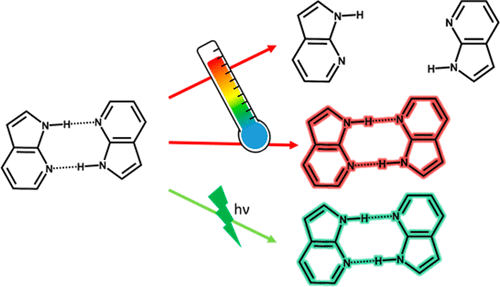当前位置:
X-MOL 学术
›
J. Phys. Chem. A
›
论文详情
Our official English website, www.x-mol.net, welcomes your feedback! (Note: you will need to create a separate account there.)
Interpreting Quasi-Thermal Effects in Ultrafast Spectroscopy of Hydrogen-Bonded Systems
The Journal of Physical Chemistry A ( IF 2.9 ) Pub Date : 2018-02-21 00:00:00 , DOI: 10.1021/acs.jpca.7b12372 Ashley M. Stingel 1 , Poul B. Petersen 1
The Journal of Physical Chemistry A ( IF 2.9 ) Pub Date : 2018-02-21 00:00:00 , DOI: 10.1021/acs.jpca.7b12372 Ashley M. Stingel 1 , Poul B. Petersen 1
Affiliation

|
Vibrational excitation of molecules in the condensed phase relaxes through vibrational modes of decreasing energy to ultimately generate an equilibrium state in which the energy is distributed among low-frequency modes. In ultrafast vibrational spectroscopy, changes in the vibrational features of hydrogen-bonded NH and OH stretch modes are typically observed to persist long after these high-frequency vibrations have relaxed. Due to the resemblance to the spectral changes caused by heating the sample, these features are typically described as arising from a hot ground state. However, these spectral features appear on ultrafast time scales that are much too fast to result from a true thermal state, and significant differences between the thermal difference spectrum and the induced quasi-thermal changes in ultrafast spectroscopy are often observed. Here, we examine and directly compare the thermal and quasi-thermal responses of the hydrogen-bonded homodimer of 7-azaindole with temperature-dependent FTIR spectroscopy and ultrafast mid-IR continuum spectroscopy. We find that the thermal difference spectra contain contributions from both dissociation of the hydrogen bonds and from frequency shifts due to changes in the thermal population of low-frequency modes. The transient spectra in ultrafast vibrational spectroscopy are also found to contain two contributions: initial frequency shifts over 2.3 ± 0.11 ps associated with equilibration of the initial excitation, and frequency shifts associated with the excitation of several fingerprint modes, which decay over 21.8 ± 0.11 ps, giving rise to a quasi-thermal response caused by a distribution of fingerprint modes being excited within the sample ensemble. This resembles the thermal frequency shifts due to population changes of low-frequency modes, but not the overall thermal spectrum, which is dominated by features caused by dimer dissociation. These findings provide insight into the changes in the vibrational spectrum from different origins and are important for assigning, analyzing, and comparing features in thermal and ultrafast vibrational spectroscopy of hydrogen-bonded complexes.
中文翻译:

解释氢键体系超快速光谱中的准热效应
凝结相中分子的振动激发通过能量降低的振动模式而松弛,最终产生一种平衡状态,在该状态下,能量在低频模式之间分配。在超快振动光谱学中,通常观察到氢键合的NH和OH拉伸模式的振动特征变化在这些高频振动松弛后会持续很长时间。由于与加热样品引起的光谱变化相似,因此通常将这些特征描述为是由热基态引起的。但是,这些光谱特征出现在超快时间尺度上,而这太快了,无法由真实的热状态产生,并且经常观察到热差光谱与超快光谱学中诱导的准热变化之间的显着差异。在这里,我们检查并直接比较了7-氮杂吲哚的氢键键合同二聚体的热响应和准热响应,其具有温度依赖性FTIR光谱和超快中红外连续光谱。我们发现,热差谱既包含氢键的解离,又包含由于低频模式的热种群变化而引起的频移。还发现超快振动光谱学中的瞬态谱包含两个贡献:与初始激发的平衡相关的初始频移超过2.3±0.11 ps,以及与几种指纹模式的激发相关的频移,其衰减超过21.8±0.11 ps ,由于在样品组内激发指纹模式而引起的准热响应。这类似于由于低频模式的总体变化而引起的热频率偏移,但与整体的热频谱不一样,这是由二聚体解离引起的特征所支配的。这些发现提供了对来自不同来源的振动光谱变化的见解,对于分配,分析和比较氢键复合物的热和超快速振动光谱学中的特征非常重要。
更新日期:2018-02-21
中文翻译:

解释氢键体系超快速光谱中的准热效应
凝结相中分子的振动激发通过能量降低的振动模式而松弛,最终产生一种平衡状态,在该状态下,能量在低频模式之间分配。在超快振动光谱学中,通常观察到氢键合的NH和OH拉伸模式的振动特征变化在这些高频振动松弛后会持续很长时间。由于与加热样品引起的光谱变化相似,因此通常将这些特征描述为是由热基态引起的。但是,这些光谱特征出现在超快时间尺度上,而这太快了,无法由真实的热状态产生,并且经常观察到热差光谱与超快光谱学中诱导的准热变化之间的显着差异。在这里,我们检查并直接比较了7-氮杂吲哚的氢键键合同二聚体的热响应和准热响应,其具有温度依赖性FTIR光谱和超快中红外连续光谱。我们发现,热差谱既包含氢键的解离,又包含由于低频模式的热种群变化而引起的频移。还发现超快振动光谱学中的瞬态谱包含两个贡献:与初始激发的平衡相关的初始频移超过2.3±0.11 ps,以及与几种指纹模式的激发相关的频移,其衰减超过21.8±0.11 ps ,由于在样品组内激发指纹模式而引起的准热响应。这类似于由于低频模式的总体变化而引起的热频率偏移,但与整体的热频谱不一样,这是由二聚体解离引起的特征所支配的。这些发现提供了对来自不同来源的振动光谱变化的见解,对于分配,分析和比较氢键复合物的热和超快速振动光谱学中的特征非常重要。



























 京公网安备 11010802027423号
京公网安备 11010802027423号